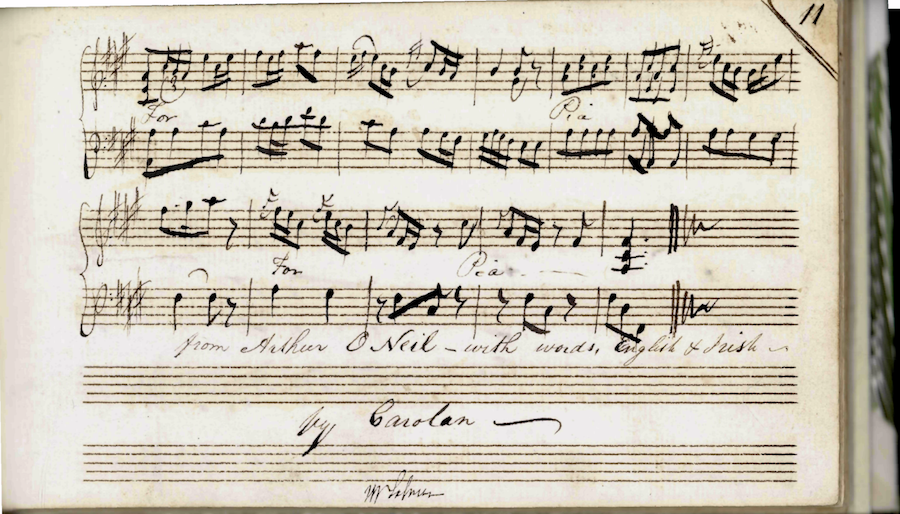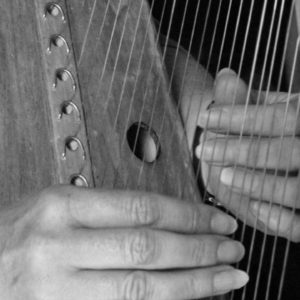The Hawk of Ballyshannon
Sources
Seabhac na hEirne / The Hawk of Ballyshannon / The Hawk of Lough Erne / Miss Moore / Caitríona Ní Mhórdha / Inghean Uí Mhórdha
This song survived in the Oriel song tradition until 1931. The County Tyrone harper, Arthur O’Neill, played it at the Belfast Harper’ Assembly in 1792. He had strong connections with the harpers, patrons and family relations in Oriel. He recalls in his Memoirs of his meeting with Oriel harpe Patrick Linden Pádraig (óg) Mac Giolla Fhiondáín in Ballynagleragh, now Ballsmill in the Fews near Crossmaglen in County Armagh, as he was on his way to the Harpers’ Assembly of 1792. He frequented the Plunkett home in Rocksavage in County Monaghan. This was a house with which harper Molaí Nic Giolla Fhiondáin also had connections (AHU pp. 346-80). It was she who composed The Green Woods of Trugh (Coillte Glasa a’ Triúcha), which O’Neill had in his repertoire, and of which his playing won him the sum of eight guineas in the Granard Harp Festivals in the early 1780s. He might well have met Molaí Nic Ghiolla Fhiondáin in Rocksavage and heard her play, although he makes no mention of this.
Arthur O’Neill from Annals of the Irish Harpers (1911). Charlotte Milligan Fox
Arthur O’Neill had relatives in Dundalk and Ballymacnabb in County Armagh and was circulating in the same social circles as William Neilson and the Bryson brothers (see here Carolan in Oriel). He recalls in his Memoirs of leaving the Plunketts of Rocksavage in County Monaghan to head to relations in Dundalk including Owen O’Neill, Captain Byrne of Castletown, George and Harry Byrne. From there he headed in snow through south Armagh and to a hostelry beyond Newtownhamilton, owned by an hospitable and welcoming Mrs McArdle, where he played all night. (Memoirs: Dónal O’Sullivan CAROLAN. 2001, p.327). Of particular interest is that the lyrics of this Carolan/Ruairí Dall Ó Catháin composition Inghean Uí Mhórdha or The Hawk of Ballyshannon had survived in the Oriel oral song tradition until 1931, when a fragment was recorded from a singer called Máire Ní Arbhasaigh (AHU pp. 391-2), from Crossmaglen, County Armagh. It it is very unusual to find a song in the repertoire of the songs of the people, and this is the only one to date in the Oriel tradition. It suggests that it filtered into the song tradition via the harpers in Oriel and would have been in their repertoire.
The following contribution is by ORIEL ARTS harper, Sylvia Crawford. See also her description of the Early Irish Harp in Oriel Harpers section here.
Click MUSIC tab beneath video above for music manuscript sources. In the video she is playing a HHSI Student Otway harp (on loan from The Historical Harp Society of Ireland), made by David Kortier (USA) and modelled on the Otway harp. The Otway (or Castle Otway) harp, was once owned by Oriel harper, Patrick Quin, and is now owned by Trinity College, Dublin.
Sylvia Crawford playing early Irish harp with fingernails. Photo: Brenda Malloy
“The Hawk of Ballyshannon was published in Bunting’s Ancient Music of Ireland, in 1840. From the index we know that he got the air from harper Arthur O’Neill, in 1792. Bunting attributes the authorship of the air to O’Cahan, in 1605.
In the introduction to Ancient Music of Ireland the title is given as Seabhac na h-Eirne, with The Hawk of Ballyshannon or O’Moore’s Daughter as alternative titles. The tune is described as ‘an altered composition by Rory Dall, being his ‘Port Atholl’ somewhat varied by Carolan, who composed words to it for Miss Moore. It was uniformly attributed to its proper composer by the harpers at Belfast.’ This suggests that this tune was played by other harpers too, or at least known to them. In the Bunting collection there are two manuscript sources of Seabhac na hEirne (see below).
Arthur O’Neill from Tyrone did visit the Oriel region, and told a story of meeting Patrick Linden /Pádraig (óg) Mac Giolla Fhiondáin in the Fews area of south Armagh, on his way to the celebrated harpers’ meeting in Belfast, in 1792. He was a friend of Edward Bunting, a County Armagh man, and provided Bunting with a number of tunes, as well as information about the harp and anecdotes about many of the old harpers. O’Neill was the teacher at the first Irish Harp Society in Belfast. One of his pupil’s, Edward McBride, taught at the second Belfast Harp Society, where Patrick Byrne was one of his pupils.
The Hawk of Ballyshannon most likely was played by Oriel harpers as this harp song survived in the oral song tradition in Oriel. What we know of the individual harpers’ repertoires comes from Bunting’s published attributions and sources, from notes contained in his manuscripts and from Bunting’s handwritten annotations in his own private copies of his published collections. Other sources that associate particular tunes with particular harpers, comes from newspaper articles and various written accounts of the harpers’ tunes. The known tune names associated with particular harpers, allows us to connect specific tunes with individual harpers, but it does not fully represent the harpers’ complete repertoires.
Among other tunes known to have been played by Arthur O’Neill, are a number of tunes that are associated with Oriel, including Coillte Glasa a’ Triúcha/ The Green Fields of Trugh, attributed to Molly Linden, thought to be the sister of Patrick Linden, who taught the harper Patrick Quin.”
Notation
“My transcription of the (unaccompanied) tune is based on MS 33(3), pp 10 & 11. The title of this version is given as ‘Seabhac na heirne / or hawk of Lough Erne, or Miss Moore‘. Underneath is written ‘from Arthur O’Neil – with words, English & Irish – by Carolan‘. There are three sharps in the key signature, which is unsuitable for an early Irish harp. Moving it down a tone, into an E minor mode, puts it in a key with one sharp, which would be suitable for an early Irish harp. There is no 6th in the tune, so it could be either dorian or aeolian mode. The bass hand accompaniment of MS 33(3) does not contain any accidentals, and it is playable on the type of harp that Arthur O’Neill played.
There are some features that are typical of what we know of how the harpers’ accompanied their tunes, for example, arpeggios played in a downward motion, and certain notes of the melody taken by the bass hand, and played an octave lower. (I indicate this feature in my transcription).
However, it is still unclear whether this accompaniment is how Arthur O’Neill would have actually played it. I suspect that it contains some elements of his bass hand, but other more harmonic features may have been added by Bunting to make it more suitable as a piano accompaniment. We cannot really know for sure.
The second manuscript version (MS 33(5), pp 31a & 31b) is undoubtedly reworked for piano. It is based on the earlier version but is more densely harmonised and contains several accidentals. It is clear that Bunting has harmonised this as F sharp minor (with the addition of an E sharp accidental). This arrangement is not playable on an early Irish harp. This appears to be the draft for the final published version.
Seabhac na hEirne or The Hawk of Ballyshannon is now a well-known air. I have heard many renditions of this tune over the years, which has undoubtedly influenced my playing and interpretation of this tune. The version I am playing in the video is not closely based on my transcription.”
Oriel Arts 2020 © Sylvia Crawford
References
- BUNTING, E. (1840). The Ancient Music of Ireland, Arranged for the Piano Forte. Dublin.
- FOX, C. M. (1911). Annals of the Irish harpers. London, Smith, Elder & Co.
- MOLONEY, C. (2000). The Irish Music Manuscripts of Edward Bunting 1773-1843. An Introduction and Catalogue. Dublin: Ceol Taisce Dúchais Éireann (Irish Traditional Music Archive).
- NÍ UALLACHÁIN, P. (2005). A Hidden Ulster. People, songs and traditions of Oriel. Four Courts Press.
- Queen’s University, Belfast, Special Collections MS 4/33(3) pp10 & 11
- Queen’s University, Belfast, Special Collections MS 4/33(5) pp31a & 31b
Music
Seabhac na hEirne – Hawk of Ballyshannon

Hawk of Ballyshannon notation Sylvia Crawford copyright

Attached – 1840 notes in introduction

Attached – 1840 published Bunting version (No.13)

MS 33(5) pp 31a by kind permission Queens University Belfast Special Collections

MS 33(3) p 10 by kind permission Queens University Belfast Special Collections

MS 33(3) p 11 by kind permission Queens University Belfast Special Collections


